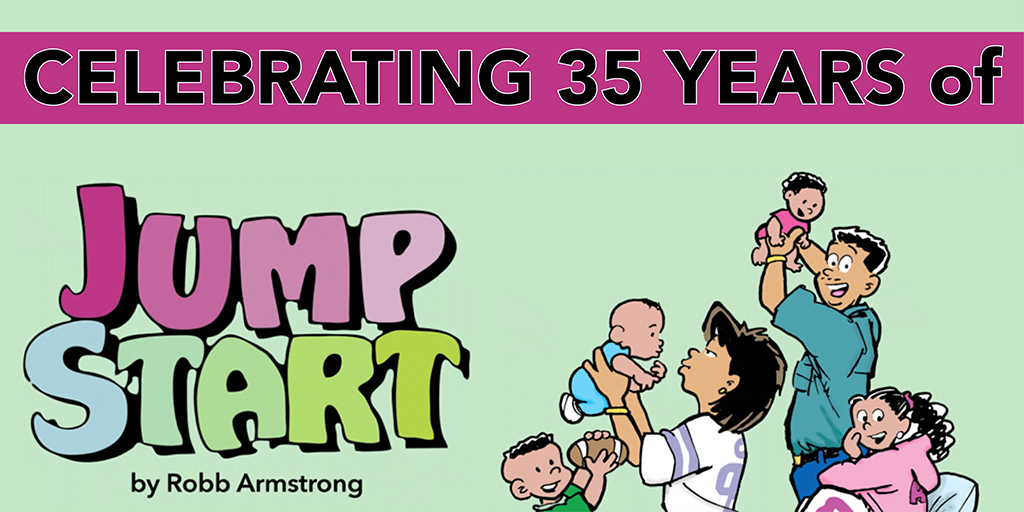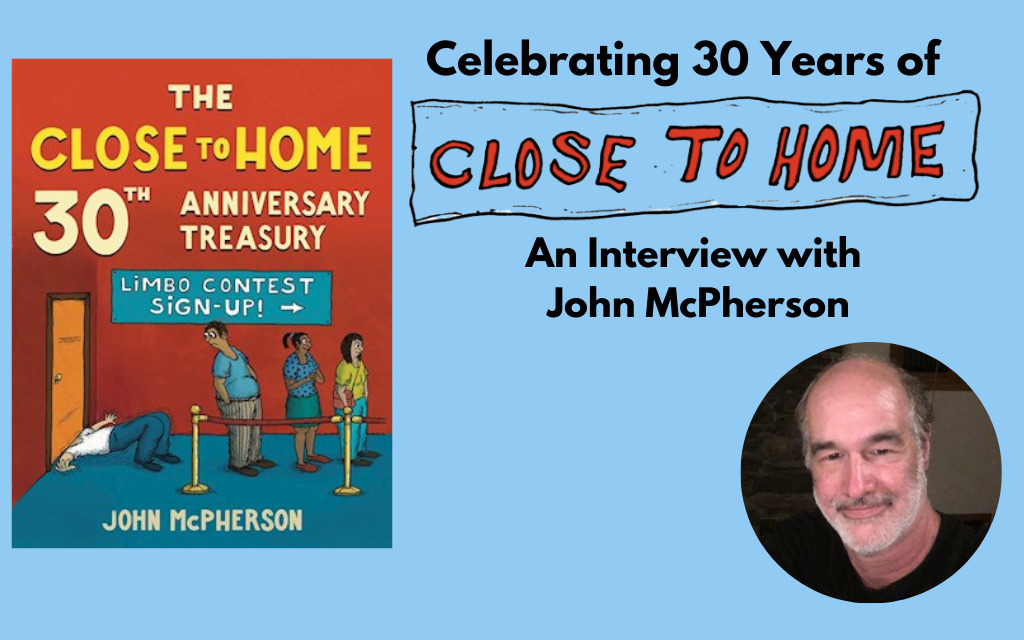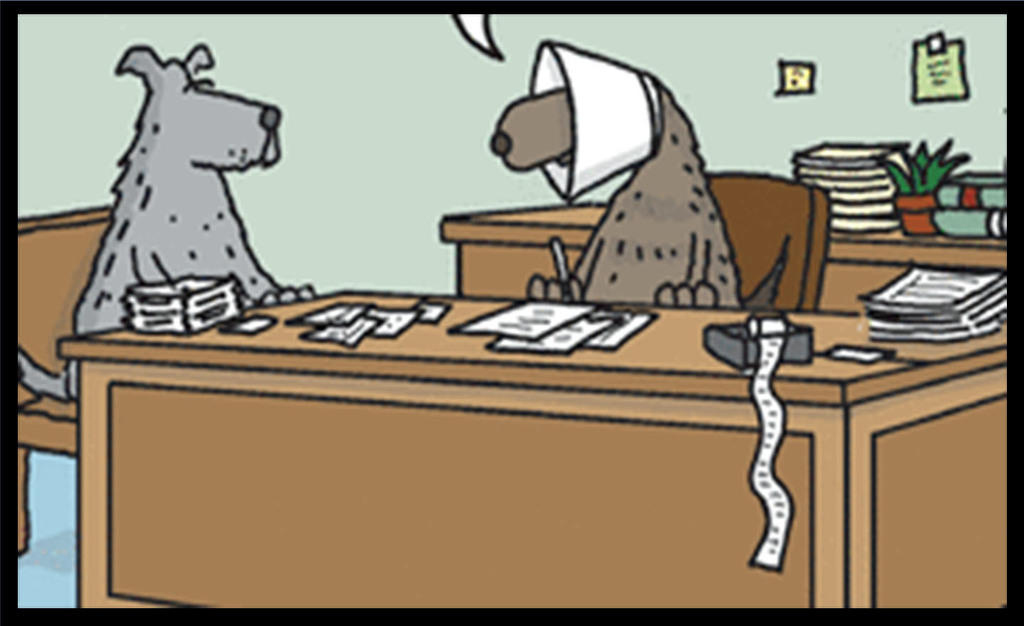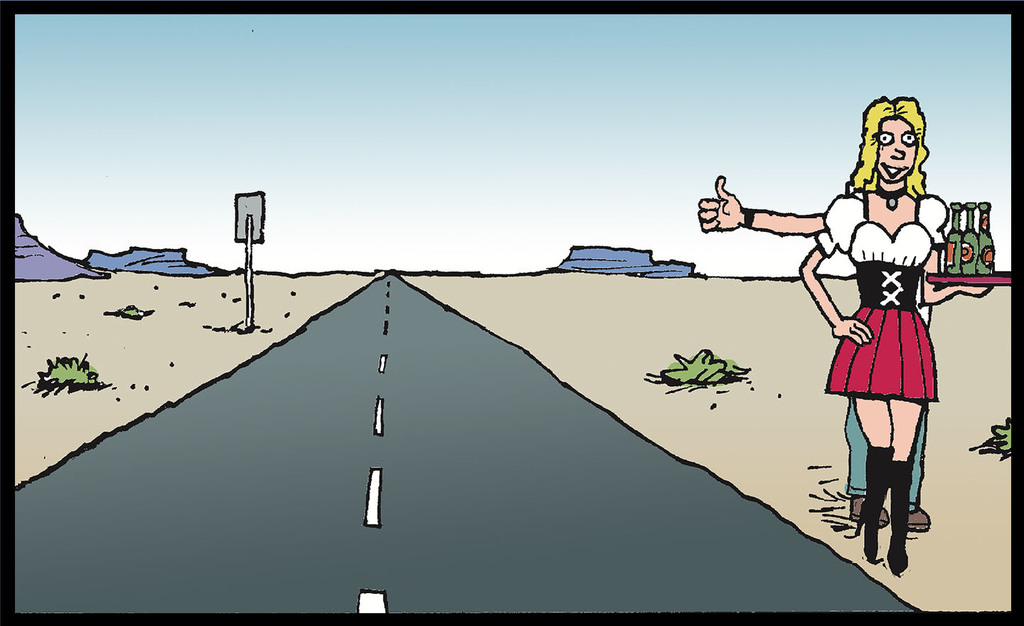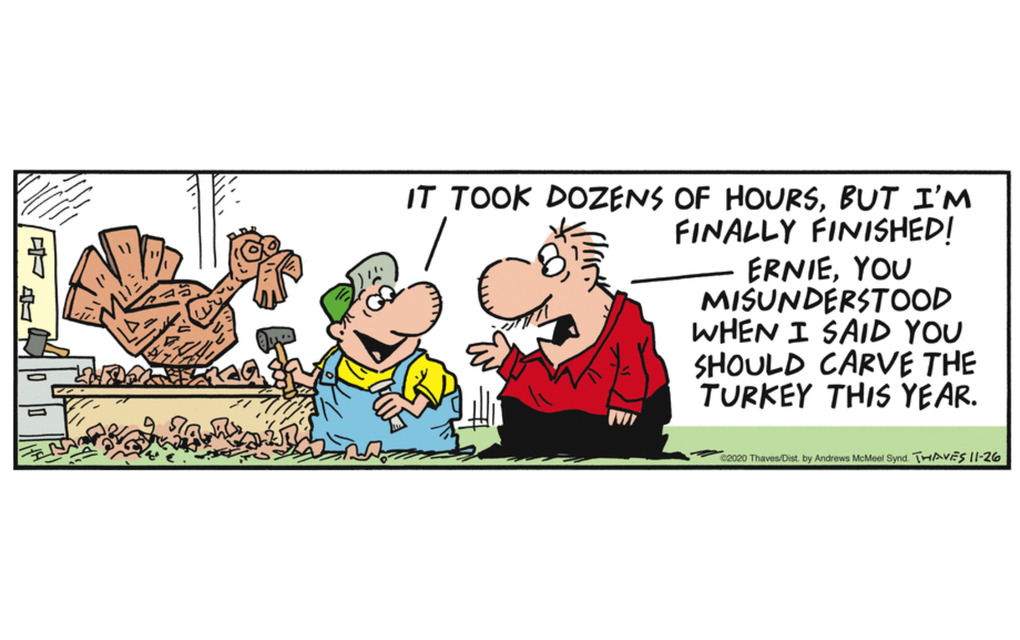Khalid Birdsong (Little Fried Chicken and Sushi)
by GoComicsThe GoComics "Meet Your Creator" series brings you firsthand insight into the lives and careers of your favorite cartoonists. Each week, we hand over the keys to one of our talented creators, who share their inspirations, achievements, creative processes, studios and more! Read on to hear from this week's featured cartoonist: Khalid Birdsong of Little Fried Chicken and Sushi
When I was a kid "...
It was the early 1980s. I loved watching Saturday morning cartoons and playing with toys based on them. Animation and toys inspired me to start drawing when I was three years old. I drew on any paper I could find, like inside of picture books, novels and even the encyclopedia. Remember those? My mother noticed my excitement for drawing and made sure to bring home reams of white paper for me to use instead of the books in our library.
When I was six, I discovered making a book was easy if you just staple paper together. So I started making comic books about characters I created, and sold them to my friends for a quarter. My illustrious career in cartooning had begun!
The funny thing was, I didn't know much about comic books at that age, but I loved the Sunday comics. Even before I could read them, I enjoyed looking at the different characters and trying to draw them.
As I grew older, I fell in love with comics like Asterix and Archie. The comic books I created were very basic, six-panel grids on each page with funny adventure stories inspired by characters from whatever famous movie or cartoon that was out at the time. "The Adventures of Agent X," my Asian hero, had a ton of cool gadgets in his jacket similar to Inspector Gadget and Data from The Goonies movie. Of course, I had to make a "Teen Wolf" comic and even combined characters from commercials and movies to come up with my version called "Indiana Raisin." I thought I was a genius!
It wasn't until I began reading superhero comics that things began to change.
The Superhero age!
I'll never forget the day in eighth grade when my father came home and gave me my first real Superman comic book. "Superman in Space!" I was in awe as I read through the dynamic visual storytelling and various layouts of the panels on each page. I remember thinking, "A comic book can really look like this?" I was hooked.
I started reading superhero comics and drawing longer-form comic books full of action and adventure. They became more about characters with powers saving the day than the humorous comics I made when I was younger. I studied different panel layouts and how to draw human anatomy accurately. It was a ton of work, but I had my heart set on becoming a comic book artist.
Which Road To Choose?
In high school, I came up with a superhero comic series called "Brothas" about three African-American men who discover they are brothers and were raised by adopted families. Their biological father was a famous superhero in the 1970s and each one of them has a different superpower they used to fight crime. I remember the excitement of staying up late drawing new issues of the comic knowing that my friends were waiting to see what happened next!
At the same time, I worked for the high school newspaper as a writer and cartoonist. Drawing humorous comic strips gave me a chance to know what it felt like to make people laugh. I realized that I could work in two different styles. The more realistic comic book style worked well for adventure stories, and I could use the exaggerated cartoony look for humor strips.
I even submitted a comic strip to syndicates. It was a strip about a psychiatrist with big spiky hair who was always talking to characters with interesting or funny life challenges. Of course, I received a ton of rejection letters. It was tough, but a good way to learn an important lesson: As a cartoonist, you will get rejected. Many times. Not all of your ideas will succeed. If something doesn't work, you can create another concept or idea and try again.
Working on both comic books and comic strips made me feel like I should choose one to focus on to truly master. I wasn't sure what direction to go in and my mother suggested I write letters to famous cartoonists for advice. Surprisingly, two of them responded!
How Professional Cartoonists Helped Guide My Way
I received a letter back from Ray Billingsley, the cartoonist of the comic strip "Curtis." He wrote that he liked my art style and encouraged me to keep drawing and trying different strip ideas. The best part - he drew an original picture of his character, Curtis, and signed it for me. I have it framed and hanging in my studio to this day!
The next one surprised me. I was actually able to visit Art Sansom who created "The Born Loser" comic strips! He was open to my mother bringing me over to visit his home so he could look at my art and talk about comics. That experience was not only exciting for a high-school kid, but also incredibly inspiring! To get feedback on my work from an actual syndicated cartoonist in his own home? It was like climbing a mountain and meeting a wise man.
After Mr. Sansom looked at both my comic strip work and comic book-style pages, he felt like I had big stories that were difficult to fit into only four panels. He recommended I continue doing more long-form comic books where I could have a big story or universe and play with the panel layouts more than in comic strips. I agreed! The design aspect of figuring out how to tell stories using different panel sizes and shapes appealed to me.
I went to art school and studied just about everything and put that knowledge into my comics.
The Path To Independent Publishing
After college, I started working freelance for local small businesses doing T-shirt designs and book illustrations. It was tough to make a living. I remember taking on all kinds of jobs to make ends meet. Working as a security guard or waiting tables was the easier choice because the schedule gave me time for client work and my comics.
Even though I loved reading and attempting to draw superhero comic books in school, they were not my favorite style to create. This was the late '90s, when mainstream comics were insanely popular! We didn't really have as big of a market for graphic novels yet. I preferred making fantasy stories similar to "BONE" and "Elfquest" that broke away from the standard superhero model.
My own fantasy series, "ORA," was turned down by several publishers after shopping it around for a year. I got fed up and decided to publish the first issue myself! Even though I couldn't even get a distributor to put it into comic shops, I sold copies of the first issue of "ORA" at comic book conventions and book shows. I learned a lot about the comics business, and people liked the book, but I didn't sell enough to print a second issue. I decided to spend more time on freelance illustration.
If I Teach, Does That Make Me A Failure?
Around the year 2000, I started teaching art in elementary school full time. I never wanted to teach because I was afraid it meant I was a failure as an artist. Like I gave up on trying to make a living only with my cartooning. I worked with kids before at after-school programs and enjoyed it, but it was shocking how much I fell in love with teaching once it became my job!
You spend your life drawing, practicing and studying art, so it's very rewarding to teach what you know to young people. Not to mention the fact that a teacher's schedule gave me time to freelance outside of work and draw comics during summer breaks!
Three years of teaching flew by and I was looking for a change, so I moved to Osaka, Japan, to work as an English teacher in junior high schools with the JET Program. What an adventure! Growing up with anime, Japanese art, language and culture really intrigued me. I lived there for two years, met my wife and moved back to the U.S. with her. There were so many unforgettable experiences, I thought it would be fun to create a comic book about them.
While in Japan, I wrote a script for a 200-page graphic novel about a girl who must travel through a city of vampire gangs in one night, entitled "Tales of Tritoria: Youngbloods." I wanted to draw that one before tackling my Japan stories. So, I spent four years drawing the comic and put up two pages a week online as my first webcomic. It was a fun way of getting feedback from readers, and exciting to have people I've never met before waiting for new pages each week! When the story was finished, I sold it online and at comic conventions.
Creating "The Fried Chicken and Sushi" Comic
At first, I called it "The Black Samurai" and planned to loosely base it on my own life, but with fantasy elements thrown in. The goal was to make it a graphic novel about an African-American man named Karl who moves to Japan and befriends a magical raccoon spirit named Tanuki. The raccoon would transport Karl back in time regularly to feudal Japan to fight monsters as a samurai. The mix of humor and action-adventure really appealed to me, so I started drawing pages.
When I heard about a comic book competition called The Comic Book Challenge 2007, where you could enter your idea and compete to win a publishing contract, I just had to enter! I was actually chosen as one of the top 50 finalists! I had to pitch my idea, American Idol-style, to a panel of judges during the hugely popular San Diego Comic-Con. Here's a video of my short pitch:
I did a decent job pitching, but I didn't win the competition. It did give me the confidence to know that this project idea might have what it takes to succeed. Making it a comic book concerned me, though. I wanted to post pages online, and I noticed that webcomics done in a more comic strip-humor style got more attention than long-form comics. Could I make it into a comic strip? I had to try!
My plan was set. I would change it into a humorous comic strip, even though I hadn't made any since high school, and put it online twice a week. "The Black Samurai" just didn't feel appropriate for the title of a humor strip. I thought about the times we visit Japan, and one of our favorite meals to eat with my wife's family is KFC fried chicken with a platter of sushi.
It was always a joke that the dinner was a stereotypical representation of my wife and me, an African-American and Japanese couple. What a great name for a comic about living in Japan as a black man! Even if my strip had nothing to do with food, it suggested the clash of two different cultures. "Fried Chicken and Sushi" the comic was born!
I posted new comics about Karl's adventures living in Osaka every Tuesday and Thursday for four years, and my readership surprisingly grew to more than 15,000 readers a month. Fans enjoyed reading about Karl dealing with culture shock, dating and even racism.
When I started the strip, I was drawing on Bristol board paper and inking with Pigma Micron pens. Two years later, I bought Manga Studio comic-making software, and now I draw all of my comics through my laptop using a Wacom Cintiq screen. This saves loads of time and makes it easy to transfer pages into Photoshop for coloring.
The antagonistic relationship between Karl and the Tanuki raccoon character was one of the most enjoyable parts of "FC&S" to create. Tanuki loved breaking Karl's plates and making life completely miserable for him. No one else could see Tanuki. He was like Karl's conscience and motivational speaker. Other times, he was a bully. Their relationship made for enjoyable cartooning and was one of the most popular elements of the strip!
You can buy the first book collection of 200 original "Fried Chicken and Sushi" comic here.
How Little FC&S moved into online syndication
Just for fun, I created about two weeks' worth of comic strips with the "Fried Chicken and Sushi" characters as kids. They were students in an international school in Osaka, Japan, trying to do well in school outside of their home country. One of the fun aspects of this version was that everyone could see the raccoon character, Tanuki, and his magical mischief caused problems for Karl and all of his friends.
Of course, I loved reading comics on GoComics, but I thought it was only for syndicated newspaper strips. I was listening to a podcast one day while drawing strips, and a cartoonist mentioned that you could submit your webcomic to Universal Uclick for online syndication. I thought, why not?
So, I wrote a query letter and put it in a PDF with about 15 of my best "FC&S" strips. Something told me to also include the run of "Little FC&S" strips I did, just in case they were looking for something with kid characters. I submitted it to Universal Uclick online, and expected to receive a rejection letter in a few months.
Fortunately, they were interested and thought that the kid version, "Little Fried Chicken and Sushi," would work well for GoComics. Thank goodness I added it in! It's been a thrill gaining a new online fan base and making comic strips about the ups and downs of living as a foreigner in Japan.
Read "Little Fried Chicken and Sushi" here. Follow along on Facebook, Twitter and Tumblr.


